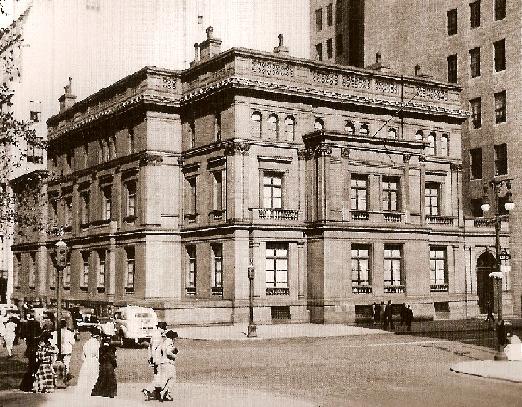The first real film made about the Titanic was the German film "Titanic". Made solely as Nazi propaganda, the film features German first officer Hans Peterson, who warns the greedy British passengers and crew that the ship is going too fast, and as a result they hit an iceberg and sink. Sink there are 3000 passengers onboard, and only enough lifeboats to hold a few hundred, many people die in the sinking. At the end of the film, the British inquiries are held. J. Bruce Ismay walks free, and all the blame is put solely on Captain Smith, who perished in the sinking.
The Dining Room, before and during the sinking.
Among the passengers traveling onboard, are White Star Line President J. Bruce Ismay and his wife, Gloria, who like all the other first-class passengers onboard are portrayed as sleazy and callous. Ismay plans are increasing the value of his and the White Star Line board-members' stock by having the Titanic win the Blue Ribbon. He cares only for himself and his money.
J. Bruce and Gloria Ismay.
Also onboard, are John Jacob Astor and his wife, Lady Astor. Astor is the richest man onboard, and he plans on buying out the Titanic from the White Star Line by purchasing %52 of their stock. Lady Astor, on the other hand, is tired of her husband looking at her as just another one of his assets, and frequently resorts to abusing her maid, Jenny, and her husband's secretary, Hopkins.
John J. and Lady Astor.
Then there is the Duchess of Canterville, who is depicted as being at least sensible, if somewhat oblivious, and Lord Archibald Douglas, who is $2 million in debt. The Duchess has never been on a ship before, because she can't swim, and only came onboard the Titanic because it is un-sinkable. Lord Douglas came aboard to find some way out of debt, and to try and steal Lady Astor's jewels, though someone else beat him to it.
The Duchess of Canterville and Lord Douglas.
The only non-corrupt first-class passenger onboard is Sigrid Olinsky, a recently impoverished Russian aristocrat, whom everyone thinks is extremely rich. She is Hans's lover, and the only passenger onboard to actually care about her servants. Ismay initially tries to charm her into helping bail out the White Star Line, though he eventually gives up due to his wife's anger. Hans then tries to get her to convince Ismay to slow the ship down.
Sigrid Olinsky.
Following the first-class passengers, are an interesting group of third-class passengers, who are, despite being rather idiotic at times, portrayed as still being better than the evil British first-class. Included are a rather dedicated couple, who look as if they belong in second-class rather than third.
Hans Peterson is right, and the ship hits an iceberg. Chaos thus ensues, and everyone begins to run around and scream. People are seen running about the get to the lifeboats, many wearing the flimsy life vests provided for by the cheap British. Out of the whole boatload of characters, only four survive. Ismay, upon hearing the news, demands a lifeboat be secured for him. After many attempts at finding rescue, Hans announces he will save him, so that he may appear in court afterwards and face justice. It is presumed Gloria survived, as she is the first person in a lifeboat, dressed in a jaguar fur coat and clutching jewelry. Later, her over-crowded lifeboat is seen being rocked back and forth by people in the water trying to climb in, and she is eventually dumped into the water.
Hans agrees to secure Ismay a lifeboat, to Captain Smith's surprise.
Gloria demands the officer lower the boat.
Sigrid tells Hans she is broke, and her takes her to the deck, where they both proceed to help distraught people into the boats. Hans convinces her to get into a boat, as they will need her to keep everyone calm. She goes reluctantly. Hans then somehow gets below decks, into a flooding first-class corridor, where he hears a little girl screaming "Mommy!". He rescues the girl who was abandoned by her callous British parents and then is thrown into the water when the ship begins to sink. All the other boats he swims past, all filled with British passengers, refuse to let him on. He finally swims to Sigrid's boat, where she demands they let him and the child onboard. They are both rescued, and later seen testifying at the hearings.
Hans testifying at the hearings.
As for the other characters, they all perish. Captain Smith goes down with his ship, ashamed he acted like an idiot and listened to Bruce Ismay orders to speed up the ship. John Astor, after hearing the news, orders Lady Astor to go up on deck and take a life vest and her jewelry box, accompanied by Hopkins. She brushes her husband aside and goes to change out of her evening gown, refusing to wear the life vest. She dies, as she could not decide what to wear. Astor then tries to buy a place in a lifeboat, but is last seen with his wife's jewelry box in the lounge. He also dies. Hopkins was presumably shot.
John Astor tries to get Lady Astor and Hopkins to go on deck.
The Duchess of Canterville is one of the last people seen on the Titanic before it sinks. She makes it out on deck, in full gilded attire wearing her life vest, as the last lifeboat departs. She ponders jumping into the boat as it pulls away, but then decides not to, putting her head down knowing she is too late. Both she and Lord Douglas die, who is last seen drinking in the lounge. Just about all the third-class characters also die.
At the end of the film, after the inquiries and hearings, the council decides that all the blame should fall only on Captain Smith, and not Ismay, who gets to walk free. Amongst the last lines in the movie talk about how Britain caused the Titanic, and how corrupt they are.
Despite all the inaccuracies, and the British hate, the movie was rather interesting, if not almost completely fictional. The movie is available on YouTube, with English subtitles.










